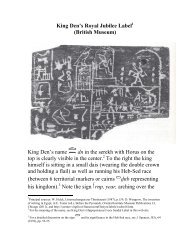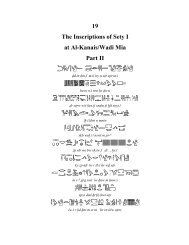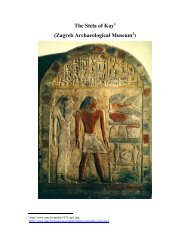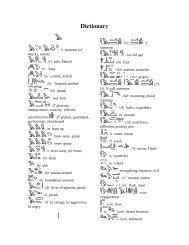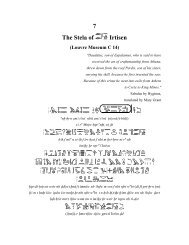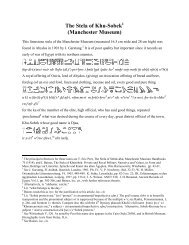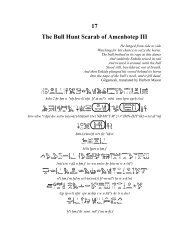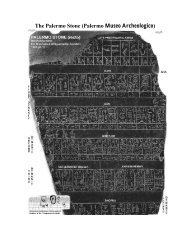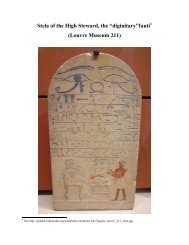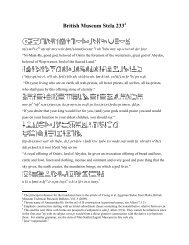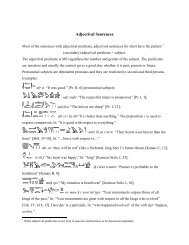11 The Second Stela of Kamose Part III - Middle Egyptian Grammar
11 The Second Stela of Kamose Part III - Middle Egyptian Grammar
11 The Second Stela of Kamose Part III - Middle Egyptian Grammar
You also want an ePaper? Increase the reach of your titles
YUMPU automatically turns print PDFs into web optimized ePapers that Google loves.
<strong>11</strong><br />
<strong>The</strong> <strong>Second</strong> <strong>Stela</strong> <strong>of</strong> <strong>Kamose</strong><br />
<strong>Part</strong> <strong>III</strong><br />
“[1.14] Says Darius the king: <strong>The</strong> kingdom which was taken away<br />
from our family, this I put in (its) place; I established it on (its)<br />
foundation; as (it was) formerly so I made it; the sanctuaries which<br />
Gaumata the Magian destroyed I restored; for the people the revenue<br />
and the personal property and the estates and the royal residences<br />
which Gaumata the Magian took from them (I restored); I established<br />
the state on (its) foundation, both Persia and Media and the other provinces;<br />
as (it was) formerly, so I brought back what (had been) taken away;<br />
by the grace <strong>of</strong> Auramazda this I did; I labored that our royal house<br />
I might establish in (its) place; as (it was) formerly, so (I made it);<br />
I labored by the grace <strong>of</strong> Auramazda that Gaumata the Magian<br />
might not take away our royal house.”<br />
<strong>The</strong> Behistun Inscription, Column I,<br />
translated by Herbert Cushing Tolman<br />
WA+-#PR-Ra di anx dAir zpw<br />
di.n.i xAswt HAt-tA Xr.i irrw m mitt<br />
ni gm.n.tw wAt nt msnb.i ni bAg.n.i Hr mSa.i ni it.t(w) Hr mH<br />
snD.n.f n.i iw.i m xd ni aHAT.n<br />
ni sprt.i r.f mA.n.f hh.i h(A)b.n.f SAa-r kSi r wxA nx.f<br />
kfa.n.i si Hr wAt ni di.i spr.s
aHa.n di.i it.tw.s n.f ann.ti wAH si Hr (i)Abtt r tp-ihw<br />
aq nxt.i m ib.f xb(A) Haw.f sDd n.f wpwti.f nA<br />
irt.n.i r pA w n inpwtt wn m xwt.f<br />
zb.n.i pDt.i nxt ntt Hrt.(t)i r xb(A) DsDs<br />
iw.i m sAkA r tm rdi wn rqw.i HA.i<br />
xnt.n.i m wsr-ib ib Aw(.w) sk rkw.i nb nti Hr tA wAt<br />
xi pA xnt nfr n pA Hq(A) anx(.w) (w)DA(.w) s(nb.w) Xr mSa.f r HAt.f<br />
nn nhw.sn ni Sn z(i) iri.f ni rm ib.sn<br />
mnmn.i r zAtw-nwt tri Axt<br />
iw Hr nb HD(.w) tA m rsfi mryt abab.Ti wAst m HAb<br />
Hmwt TAww iw.w(i) r mA n.i zt nbt Hpt(.ti) snnw.s nn Hr Xr rmyt<br />
snTr n imn r Xnw-pr zp 2 r bw Dd.tw im<br />
Szp bw-nfr mi dd.f pA xpS n zA-imn anx(.w)-(w)DA(.w) s(nb.w)
(n)swt wAH WA+-#PR-Ra zA-ra KA-M%W di anx<br />
dAir rsw sAsA mHt it pA tA m nxt di anx Dd wAs<br />
Aw ib.f Hna kA.f mi ra Dt nHH<br />
wD Hm.f n (i)r(i)-pat HAti-a Hri-sStA n pr-nswt Hr(i)-tp n tA r Dr.f xtmt(i)-biti<br />
sbA-tAwi HAti (i)m(i)-r smrw (i)m(i)-r xtmt(i) wsr-nSA<br />
imi ir.tw irt.n nbt Hm.i m nxt Hr wD<br />
Htp st.f m ipt-st m wAst r nHH Hna Dt<br />
Dd.in.f xft Hm.f irr.i xft wD.tw.n… nbt r Hzt nt xr nswt<br />
imi-r xtmt(i) nSi
<strong>The</strong> <strong>Second</strong> <strong>Stela</strong> <strong>of</strong> <strong>Kamose</strong>: <strong>Part</strong> <strong>III</strong><br />
subdue, suppress<br />
dAr control, punish,<br />
mHi (adjective-verb) concerned;<br />
(noun) care<br />
return<br />
hh flame, scorch<br />
wxA seek<br />
nX protection, defense, aid<br />
ann turn/bring/come back,<br />
tp-iHw Atfih (Aphroditopolis)<br />
wpwti messenger<br />
, inpwtt Cynopolis<br />
zbi send<br />
pDt troop <strong>of</strong> soldiers<br />
Hrti travel by land, march<br />
DsDs Baharia Oasis<br />
sAkA Sako (el-Qes)<br />
rqw enmity, opponent,<br />
tilting (<strong>of</strong> balance)<br />
xi what<br />
HA behind, around<br />
ski destroy<br />
Sni question (someone),<br />
inquire into (a matter)<br />
, iri companion<br />
rmi weep<br />
Vocabulary<br />
mnmn moor, move<br />
slowly/quickly, move about<br />
incense<br />
zAtw-nwt district <strong>of</strong> <strong>The</strong>bes<br />
HD (adjective-verb) bright, white<br />
rsfi game, abundance<br />
mryt riverbank, shore, quay<br />
wAst <strong>The</strong>bes<br />
HAb festival<br />
abab become excited<br />
TAy male, man<br />
rmyt tears<br />
snTr cense, perfume with/burn<br />
bw place<br />
xpS scimitar<br />
, kA ka<br />
, (i)r(i)-pat (hereditary)<br />
prince, member <strong>of</strong> the elite<br />
HAt(i) a high <strong>of</strong>ficial, lit. he<br />
whose arm is in front<br />
, Hri-sStA master<br />
<strong>of</strong> the privy matters, lit. he who is over<br />
the secrets<br />
Hri tp chief, nomarch<br />
xtm seal<br />
xtm valuables, treasure
, biti king <strong>of</strong> Lower Egypt<br />
xtmt(i)-biti treasurer/seal bearer<br />
<strong>of</strong> the king <strong>of</strong> Lower Egypt<br />
dwA tAwi star/conductor <strong>of</strong> the Two<br />
Lands<br />
HAti leader, lit. who is in front<br />
, , (i)m(i)-r overseer<br />
, smr courtier<br />
, wD stela<br />
ipt-swt, ipt-st<br />
Karnak, lit. Most Select <strong>of</strong> Place(s)<br />
, nHH eternity, forever,<br />
eternal/continual repetition
<strong>The</strong> <strong>Second</strong> <strong>Stela</strong> <strong>of</strong> <strong>Kamose</strong>: <strong>Part</strong> <strong>III</strong><br />
<strong>Grammar</strong> Points<br />
WA+-#PR-Ra di anx dAir zpw<br />
<strong>The</strong> unusual epithet following the usual di anx after the throne name WA+-#PR-Ra <strong>of</strong><br />
<strong>Kamose</strong> is just the beginning <strong>of</strong> the several ways <strong>Kamose</strong> describes his power as a king.<br />
Due to the many meanings <strong>of</strong> zp, the epithet in question can have essentially two<br />
translations. To begin with, dAir is a variant spelling <strong>of</strong><br />
dAr “control, punish, subdue, suppress” and due to its position in the<br />
text it must be in an active participle form. Combined with zpw translations <strong>of</strong> the epithet<br />
can vary from the mild “he who controls (the controller <strong>of</strong>) the events” to the more<br />
aggressive “punisher <strong>of</strong> the misdeeds.”<br />
di.n.i xAswt HAt-tA Xr.i irrw m mitt<br />
<strong>The</strong> phrase rdi Xr, lit. “put under” has the obvious meaning <strong>of</strong> “taking possession.” <strong>The</strong><br />
verb rdi itself is circumstantial sDm.n.f /perfect indicating competed action. xAst here<br />
clearly means “desert land” and not “foreign land” as <strong>Kamose</strong> is still struggling to unite<br />
just Egypt. Depending on the interpretation <strong>of</strong> the noun HAt “front, beginning,” the<br />
location HAt-tA can mean “Southland,” lit. “front <strong>of</strong> the land” (Faulkner), or “border land,”<br />
lit. “before the land” (Lichtheim). For mitt see the discussion at the beginning <strong>of</strong> the Story<br />
<strong>of</strong> the Shipwrecked Sailor.<br />
ni gm.n.tw wAt nt msnb.i ni bAg.n.i Hr mSa.i ni it.t(w) Hr mH.i<br />
snD.n.f n.i iw.i m xd ni aHAT.n<br />
<strong>The</strong> negated circumstantial sDm.n.f /perfect <strong>of</strong> gmi “find” with the impersonal suffix<br />
pronoun tw and object wAt “way, path, road” has passive meaning <strong>of</strong> inability, lit. “one<br />
was unable to/cannot find.” For the second part <strong>of</strong> the indirect genitive that follows
Habachi 1 notes that a few nouns <strong>of</strong> <strong>Middle</strong> <strong>Egyptian</strong> are formed by prefixing a verb with<br />
the so-called “formative” m (and dropping an initial weak consonant i or w if needed).<br />
For example, wrH “anoint” gives mrHt “oil” and wnx “clothe<br />
(oneself)” gives mnHt “clothing.” <strong>The</strong> noun msnb can then be viewed as derived<br />
from the verb sbn “fall, slip, go astray” (after a graphic transposition) via<br />
prefixing it with the “formative” m. With this, it could mean “downfall.” Smith and Smith<br />
agree with the m-formation but believe that it the verb in question is not sbn but ,<br />
snb “overstep” (without graphic transposition), with the suffix pronoun the literal<br />
meaning is: “overthrowing/assailing me…”<br />
In the next negated circumstantial sDm.n.f /perfect the adjective-verb bAgi “weary, lazy”<br />
should mean “negligent.” It appears in an adverb clause giving the reason why the<br />
previous clause is true. Being in negated circumstantial sDm.n.f /perfect, it should express<br />
a general statement: <strong>Kamose</strong> is never negligent <strong>of</strong> his army.<br />
<strong>The</strong> next clause ni it.t(w) Hr mH.i is short but not without difficulty. First <strong>of</strong> all, the<br />
irrigated canal determinative points to location, and the seated man should be a suffix<br />
pronoun, so that a direct interpretation <strong>of</strong> the noun phrase mH.i is “my north.” <strong>The</strong>n<br />
Hr is a preposition, and along with the negated circumstantial sDm.n.f /perfective <strong>of</strong> iti with<br />
impersonal suffix pronoun the whole clause can be interpreted as the one (Apophis) on<br />
north <strong>of</strong> me (<strong>Kamose</strong>) has not seized/acquired. On the other hand, it is tempting to recall<br />
the idiom iti Hr “avert attention,” lit. “take away the face.” Accepting this, the difficulty<br />
then lies in understanding the noun (phrase) . On the one hand, (ignoring the irrigated<br />
canal determinative and possibly replacing with ) it can be considered as derived<br />
from the adjective-verb mHi “concerned.” Attached to Hr as a direct genitive, the whole<br />
clause could express the general statement that a concerned man has not averted his<br />
attention (from taking care <strong>of</strong> his army, in <strong>Kamose</strong>’s case), lit. “the face <strong>of</strong> a concerned<br />
man has not been taken away.” Finally, emphasizing the irrigated canal determinative,<br />
1 Op. cit.
mH may have to be augmented to mHt “north” or even mHti “northerner.” With this,<br />
the literal meaning is that “the face <strong>of</strong> the north(ener) has not been averted” from<br />
<strong>Kamose</strong>’s sight.<br />
<strong>The</strong> last three clauses present no grammatical problems. <strong>The</strong> main clause starts with the<br />
circumstantial sDm.n.f /perfect <strong>of</strong> the verb snD “become afraid” and the suffix pronoun .f is<br />
refers to Hyksos ruler. <strong>The</strong> two circumstantial clauses state that even when <strong>Kamose</strong> was<br />
far away from Apophis, and with the negated sDmt.f construction ni aHAT.n “(even) before<br />
we fought” both emphasize the Hyksos ruler’s frightened state <strong>of</strong> mind. Note the<br />
archaizing presence <strong>of</strong> T instead <strong>of</strong> t.<br />
ni sprt.i r.f mA.n.f hh.i h(A)b.n.f SAa-r kSi r wxA nx.f<br />
kfa.n.i si Hr wAt ni di.i spr.s<br />
Another ni sDmt.f construction continues the previous line <strong>of</strong> thought, and the<br />
circumstantial sDm.n.f /perfect <strong>of</strong> the transitive verbs mAA “see” and hAb “send, send word”<br />
emphasize Apophis’ panic to <strong>Kamose</strong>’s impending arrival. <strong>The</strong> use <strong>of</strong> the noun hh<br />
“flame, scorch” should be understood only figuratively. <strong>The</strong> r + infinitive construction<br />
applied to the verb wxA “seek” is used to tell the purpose <strong>of</strong> sending a<br />
messenger.<br />
<strong>The</strong> feminine dependent pronoun si obviously refers to wpwt “message” as a previous line<br />
kfa.n.i wp(w)t.f is repeated here with the object replaced by si. In the last clause one would<br />
have expected the negated indicative/perfective sDm.f (or the circumstantial sDm.n.f<br />
/perfect). <strong>The</strong> indicative/perfective <strong>of</strong> rdi however uses the base stem rdi. Thus, this<br />
should be negated prospective/subjunctive sDm.f with interpreted as , and ni di.f<br />
meaning: “I would not let/allow.” This is the first part <strong>of</strong> a rdi sDm.f construction with the<br />
prospective/subjunctive <strong>of</strong> the verb spr and with suffixed subject .s, lit. “I would not allow<br />
that it may arrive.” This once more emphasizes <strong>Kamose</strong>’s great catch.
aHa.n di.i it.tw.s n.f ann.ti wAH si Hr (i)Abtt r tp-ihw<br />
A further humiliation for the Hyksos ruler is expressed by the rdi + prospective<br />
/subjunctive sDm.fconstruction (with rdi also prospective/subjunctive) applied to the verb<br />
iti which, along with the preposition n, means “take (back) to.” <strong>The</strong> subject in question is<br />
again wpwt referred to by the suffix pronoun .s.<br />
In stative, 2ae-gem. verbs such as ann “turn/bring/come back, return” (usually)<br />
use the base stem. Being transitive, the stative has passive meaning. <strong>The</strong> 3FS stative suffix<br />
once again refers to wpwt. <strong>The</strong> verb form <strong>of</strong> wAH is a perfective active participle “which<br />
is/was left” serving as an adjectival predicate and modifying wpwt. This reference is<br />
repeated one last time in the form <strong>of</strong> a dependent pronoun si. <strong>The</strong> construction wAH si is an<br />
alternative (and not very frequent) substitute <strong>of</strong> the stative wAH.ti. Finally, note the peculiar<br />
spelling <strong>of</strong> the (feminine) nisbe iAbtt “the East,” here meaning “the east side”<br />
to/at tp-iHw “Atfih.”<br />
aq nxt.i m ib.f xb(A) Haw.f sDd n.f wpwti.f nA<br />
irt.n.i r pA w n inpwtt wn m xwt.f<br />
Apophis’ state <strong>of</strong> mind and body is described here when he heard what <strong>Kamose</strong> did to<br />
Cynopolis , the 17 th Nome <strong>of</strong> Upper Egypt. This is north <strong>of</strong> Cusae, the boundary<br />
between the <strong>Egyptian</strong>s and the Asiatics during the <strong>Second</strong> Intermediate Period, Hyksos<br />
territory. Presumably Apophis already heard the news at the time so that the indicative<br />
/perfective sDm.f <strong>of</strong> the verb aq in the <strong>Egyptian</strong> idiom aq m ib “astound,” lit. enter/penetrate<br />
into the heart” is used for the Hyksos ruler’s state <strong>of</strong> mind, and the passive <strong>of</strong> the verb xbA<br />
“wreck” detail the state <strong>of</strong> his body, the object Haw.f. <strong>The</strong> circumstantial/imperfective<br />
sDm.f <strong>of</strong> the verb sDd “relate” is employed in the following circumstantial clause<br />
describing concomitant action. What (lit. “that (which)” expressed by nA) the messenger<br />
told Apophis is introduced by a perfect relative form <strong>of</strong> iri (modifying nA). Finally, the last<br />
clause containing the perfective active participle <strong>of</strong> the verb wnn reminds him <strong>of</strong> his lost<br />
possession.
zb.n.i pDt.i nxt ntt Hrt.(t)i r xb(A) DsDs<br />
iw.i m sAkA r tm rdi wn rqw.i HA.i<br />
<strong>Kamose</strong> dispatched a strong force described by the circumstantial sDm.n.f /perfect <strong>of</strong> the<br />
verb zbi “send, dispatch.” <strong>The</strong> attached relative clause contains a subject-stative<br />
construction in which the preposed subject is the feminine relative adjective ntt (referring<br />
to the feminine antecedent pDt). <strong>The</strong> verbal predicate is Hrti “travel by land, march.” Since<br />
its stative stem ends with t, in the 3FS stative suffix the t is omitted. <strong>The</strong> objective <strong>of</strong> the<br />
force is expressed by the r + infinitive construction.<br />
<strong>The</strong> next adverb clause states that <strong>Kamose</strong> stays in sAkA “Sako” (el-Qes) and his own<br />
purpose is described by another r + infinitive construction. <strong>The</strong> infinitive in question is<br />
actually negated with the negative verb tm + negatival complement <strong>of</strong> the verb rdi. This is<br />
the first part <strong>of</strong> a rdi + prospective/subjunctive sDm.f construction employing the base<br />
form <strong>of</strong> wnn. <strong>The</strong> whole sentence is made clear by the object rkw “enmity, malice” and<br />
the final prepositional phrase.<br />
xnt.n.i m wsr-ib ib Aw(.w) sk rkw.i nb nti Hr tA wAt<br />
<strong>Kamose</strong>’s final cleanup operations are summarized here in four clauses with simple<br />
grammar. <strong>The</strong> scribal error in (the transitive use <strong>of</strong>) the verb ski “destroy” has been<br />
emended to the correct biliteral . <strong>The</strong> verb form sk is concomitant circumstantial<br />
/imperfective sDm.f (with omitted subject).<br />
xi pA xnt nfr n pA Hq(A) anx(.w) (w)DA(.w) s(nb.w) Xr mSa.f r HAt.f<br />
nn nhw.sn ni Sn z(i) iri.f ni rm ib.sn<br />
Once again a simple grammar describes <strong>Kamose</strong>’s return to the capital. <strong>The</strong> interjectional<br />
xi “what!” should be related to the interrogative ix “what?” but this is its only
appearance before the 19 th Dynasty. It introduces an adverbial sentence with a long<br />
subject, an indirect genitival phrase A n B in which A is the noun phrase pA xnt nfr with<br />
the infinitive <strong>of</strong> xnti (as a noun) and B is pA HqA lph. (<strong>The</strong> abbreviated phrase<br />
anx(.w)-(w)DA(.w)-s(nb.w) “alive, sound, and healthy” is abbreviated as lph.)<br />
<strong>The</strong> adverbial predicate emphasizes <strong>Kamose</strong>’s triumphal march in front <strong>of</strong> his army. <strong>The</strong><br />
three clauses are all negative constructions. <strong>The</strong> first is a negated adverb clause a variant<br />
<strong>of</strong> which we already met at the Story <strong>of</strong> the Shipwrecked Sailor<br />
nn nhw n mSa.n 2 . <strong>The</strong> last two adverb clauses have verbal predicates, the<br />
negated indicative/perfective sDm.f <strong>of</strong> the verbs Sni “question (someone)” and rmi “weep.”<br />
<strong>The</strong>y describe the benevolent comradeship among the soldiers.<br />
mnmn.i r zAtw-nwt tri Axt<br />
iw Hr nb HD(.w) tA m rsfi mryt abab.Ti wAst m HAb<br />
Hmwt TAww iw.w(i) r mA n.i zt nbt Hpt(.ti) snnw.s nn Hr Xr rmyt<br />
A change in the narrative, <strong>Kamose</strong>’s arrival to home, is indicated in the main clause by the<br />
narrative infinitive <strong>of</strong> the verb mnmn which, according to Habachi must mean “moor” or<br />
“move slowly/quickly.” This is doubted by Smith and Smith who believe that this verb<br />
must mean “shake, rattle” caused by the procession <strong>of</strong> chariots. A good comparison is tA<br />
Hr mnmn, the shaking <strong>of</strong> the earth in the Story <strong>of</strong> the Shipwrecked Sailor. 3 <strong>The</strong> time is the<br />
season <strong>of</strong> Inundation, where is a variant spelling <strong>of</strong> tr “season.”<br />
Although HD Hr is a clearly understood nfr Hr construction meaning “cheerful,” lit. “bright<br />
<strong>of</strong> face,” the particle and the word order tells that the next main clause contains a subjectstative<br />
construction applied to the adjective-verb HD “bright” expressing the state <strong>of</strong> the<br />
people welcoming <strong>Kamose</strong>. In fact, the four clauses in this passage split into a pair <strong>of</strong><br />
2 [ShS. 7].<br />
3 [ShS, 59].
subject-stative constructions and a pair <strong>of</strong> clauses with adverbial predicates intertwined.<br />
<strong>The</strong> subject-stative construction continues in the next passage describing the curious<br />
<strong>The</strong>bans and an imbedded r + infinitive construction expresses their purpose: “to look.”<br />
<strong>The</strong> joy <strong>of</strong> women seeing their loved ones to come home is expressed in yet another<br />
subject-stative construction, this time applied to the transitive verb Hpt “embrace.” Once<br />
again, the stative suffix is suppressed since the verb stem ends with t. A negated adverb<br />
clause containing the possessive construction Xr rmyt “in tears,” lit. “under tears” ends this<br />
beautiful passage.<br />
snTr n imn r Xnw-pr zp 2 r bw Dd.tw im<br />
Szp bw-nfr mi dd.f pA xpS n zA-imn anx(.w)-(w)DA(.w) s(nb.w)<br />
(n)swt wAH WA+-#PR-Ra zA-ra KA-M%W di anx<br />
dAir rsw sAsA mHt it pA tA m nxt di anx Dd wAs<br />
Aw ib.f Hna kA.f mi ra Dt nHH<br />
snTr here is not the noun “incense” but the verb “cense, perfume with/burn incense” in<br />
infinitive stating that <strong>Kamose</strong>, after the successful campaign, makes <strong>of</strong>ferings to Amun.<br />
<strong>The</strong> sings indicate that the god have fallen victim to iconoclasm in the Amarna period and<br />
have only been partially restored. This points to the fact that the stela was still standing in<br />
the time <strong>of</strong> Akhenaten. 4 <strong>The</strong> place at which this is performed is the Holy <strong>of</strong> the Holies, the<br />
sanctuary, indicated by the <strong>Egyptian</strong> ditto sign zp to be applied (only) to pr, lit. “the<br />
enclosure <strong>of</strong> the enclosure(s).” (With the exception <strong>of</strong> magical spells, zp 2 applies only to<br />
the preceding word.) Concomitant to the action snTr, the circumstantial /imperfective<br />
sDm.f <strong>of</strong> Dd “say” is used to introduce the imperative Szp bw nfr “Receive good things!”<br />
<strong>The</strong> preposition mi governs an unmarked noun clause containing the nonattributive<br />
4 See Smith-Smith, op. cit.
imperfective relative form dd.f “he gives” <strong>of</strong> rdi “give” (where the original sign is<br />
emended to ). Here Amun, is indicated only by the suffix pronoun .f and the recipient<br />
<strong>of</strong> the scimitar is the the victorious son <strong>of</strong> Amun.<br />
<strong>The</strong> rest <strong>of</strong> this passage contains a number <strong>of</strong> common epithets and phrases for <strong>Kamose</strong>.<br />
<strong>The</strong> verb forms <strong>of</strong> wAH “endure,” dAir “subdue,” sAsA “overthrow,” iti/iTi “seize” are all<br />
active participles. As opposed to the typical subject-stative construction ib Aw(.w)<br />
above, in the last clause Aw is an adjectival predicate.<br />
wD Hm.f n (i)r(i)-pat HAti-a Hri-sStA n pr-nswt Hr(i)-tp n tA r Dr.f xtmt(i)-biti<br />
sbA-tAwi HAti (i)m(i)-r smrw (i)m(i)-r xtmt(i) wsr-nSA<br />
imi ir.tw irt.n nbt Hm.i m nxt Hr wD<br />
Htp st.f m ipt-st m wAst r nHH Hna Dt<br />
<strong>The</strong> infinitive <strong>of</strong> wD “command” introduces <strong>Kamose</strong>’s order to set up the stela which we<br />
have been analyzing and which is about to end here. (Alternatively, wD can also be the<br />
noun “decree,” the first part <strong>of</strong> the direct genitive wD Hm.f.) <strong>The</strong> command/decree is<br />
directed to wsr-nSA whose name is preceded with a long list <strong>of</strong> his titles. Although the<br />
middle part in the name is badly eroded in this part <strong>of</strong> the stela, one seems<br />
to make out the bottom <strong>of</strong> . In this case, the name is an alternate spelling <strong>of</strong><br />
nSi.<br />
<strong>The</strong> rdi + prospective/subjunctive sDm.f construction introduces the royal decree in which<br />
rdi is in imperative imi, and the prospective/subjunctive <strong>of</strong> iri with the impersonal suffix<br />
pronoun tw has passive meaning, lit. “have one put.” <strong>The</strong> object is introduced with the<br />
perfect relative form irt.n <strong>of</strong> iri. This relative form itself has a modifier nbt and subject:<br />
“all that my majesty has done.”
<strong>The</strong> perfective relative form <strong>of</strong> Htp “set, rest” is used to point to the location where the<br />
stela will be located. <strong>The</strong> coreferent <strong>of</strong> this relative clause is st.f with the suffix pronoun<br />
referring to the stela, lit. “which its place shall rest.”<br />
Dd.in.f xft Hm.f irr.i xft wD.tw.n… nbt r Hzt nt xr nswt<br />
imi-r xtmt(i) nSi<br />
A sDm.in.f verb form applied to Dd introduces Neshi’s speech which is unfortunately in a<br />
badly eroded part <strong>of</strong> the stela. <strong>The</strong> verb form <strong>of</strong> iri is still visible, and given the context it<br />
is the nonattributive imperfective relative form irr.i with the (conjectural) emphasized<br />
prepositional phrase xft wD.tw.n… nbt “(it is) according all that was commanded (that) ...”<br />
(<strong>The</strong> lacuna can easily be filled with the (conjectural) dative n.i.) A similar example to this<br />
construction is sqdd tA xft wD.k 5 . <strong>The</strong> rest <strong>of</strong> the sentence is<br />
less obscure. In an indirect genitival construction the clash <strong>of</strong> the indirect genitive with the<br />
preposition xr (followed by “king”) is well-attested, and the literal meaning “<strong>of</strong> with” can<br />
be mended as “from.” For example, at the end <strong>of</strong> <strong>The</strong> Story <strong>of</strong> Sinuhe we find<br />
Hzwt nt xr nswt 6 (with honorific transposition), and also<br />
imAxy n xr nswt 7 . Finally, the insertion <strong>of</strong> the (conjectural)<br />
preposition r makes the whole reconstruction now feasible.<br />
Bibliography<br />
Text: P. Lacau, Une stèle du roi “Kamosis” in ASAE 39 pp. 245-249; L. Habachi, <strong>The</strong><br />
<strong>Second</strong> <strong>Stela</strong> <strong>of</strong> <strong>Kamose</strong> and his Struggle against the Hyksos Ruler and his Capital,<br />
Abhandlungen des Deutschen Archäologischen Instituts, Kairo: Ägyptologische Reihe:<br />
Band 8, Glückstadt, 1972.<br />
5 [Peas. B1, 299].<br />
6 [Sin. B. 310].<br />
7 [BH. i. 24, <strong>11</strong>5-<strong>11</strong>6]
Commentaries/<strong>Grammar</strong>: W. Helck, Historisch-biographische Texte der 2.Zwischenzeit,<br />
82-97G.; G. Posener, RdE 33 (1981), 138-140; Habachi, op. cit.; W. Helck, Historisch-<br />
Biographische Texte der 2. Zwischenzeit und Neue Texte der 18. Dynastie, 2 nd rev. ed.,<br />
Wiesbaden, (1983) 82-98; A. H. Gardiner, JEA 3 (1916) 95-<strong>11</strong>0; H.S. Smith and A.Smith,<br />
A reconsideration <strong>of</strong> the <strong>Kamose</strong> texts, ZÄS 103 (1976) 48-76.<br />
Translations: Habachi, op. cit.; Smith and Smith, op. cit.; Pritchard, II, pp. 89-93, W. K.<br />
Simpson, pp. 348-350; T. Säve-Söderbergh, <strong>The</strong> Nubian Kingdom <strong>of</strong> the <strong>Second</strong><br />
Intermediate Period in Kush IV, p.54;



